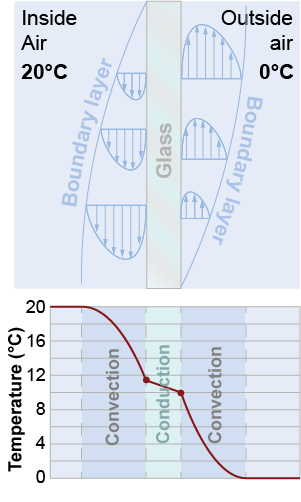|
Convection is the movement of heat through the motion of matter, in the form of flowing gas or liquid. Convection can transfer heat very rapidly. As an example, consider a glass window in still air separating an inside temperature of 20ºC from an outside temperature of 0ºC. 
| 
|
Near the inner surface of the glass the air is cooled and sinks. The farther the air is from the top of the glass, the faster it moves. A boundary layer of downward moving cool air flows down the window. Put your hand near the bottom of a window on a cold day and you can feel the draft created by this cold layer of air falling from the glass surface. The opposite happens on the cold outside of the glass. Air near the bottom warms up and rises. An upward moving boundary layer forms on the outside carrying heat upward. 
|
To compare the heat transferred by conduction and convection, consider heat moving across the 20 cm of air next to the window. Air is a good insulator and the heat conduction is small, less than 3 W across a square meter. In comparison, the heat flow by free convection is more than 100 W! This is thirty times greater. The important conclusion is that convection is far more effective at moving heat in liquids and gases than conduction. In almost all cases in which heat moves through a fluid (liquid or gas) convection plays a major role, usually exceeding conduction by at least an order of magnitude. 
|

|
Consider the same window in a stiff wind. Wind allows cold air to replace warm air right at the window surface far more rapidly. The heat transfer rate typically increases by a factor of 10–100. Forced convection, in which fluid is moved by an external source (such as wind), is an extremely effective way to move heat. 
|
When water boils in a pot, the heat is typically applied at the bottom. If you watch carefully, you can see convection occur. Heated water rises in multiple convection cells, which mix cooler water near the top with heated water near the bottom. 
|
Which of the following can most likely be explained by convection? - A stone dropped into a pond soon comes to the same temperature as the pond water.
- The water in a tea kettle makes swirling currents when heated strongly from the bottom.
- A builder of a passive-solar house uses south-facing windows to absorb as much heat as possible from the Sun in the winter months.
 |
Choice b is correct. Watch water boil in a pot and you will observe vigorous convection currents circulating from the bottom of the pot nearest the heat to the surface where the temperature is lowest. 
|

